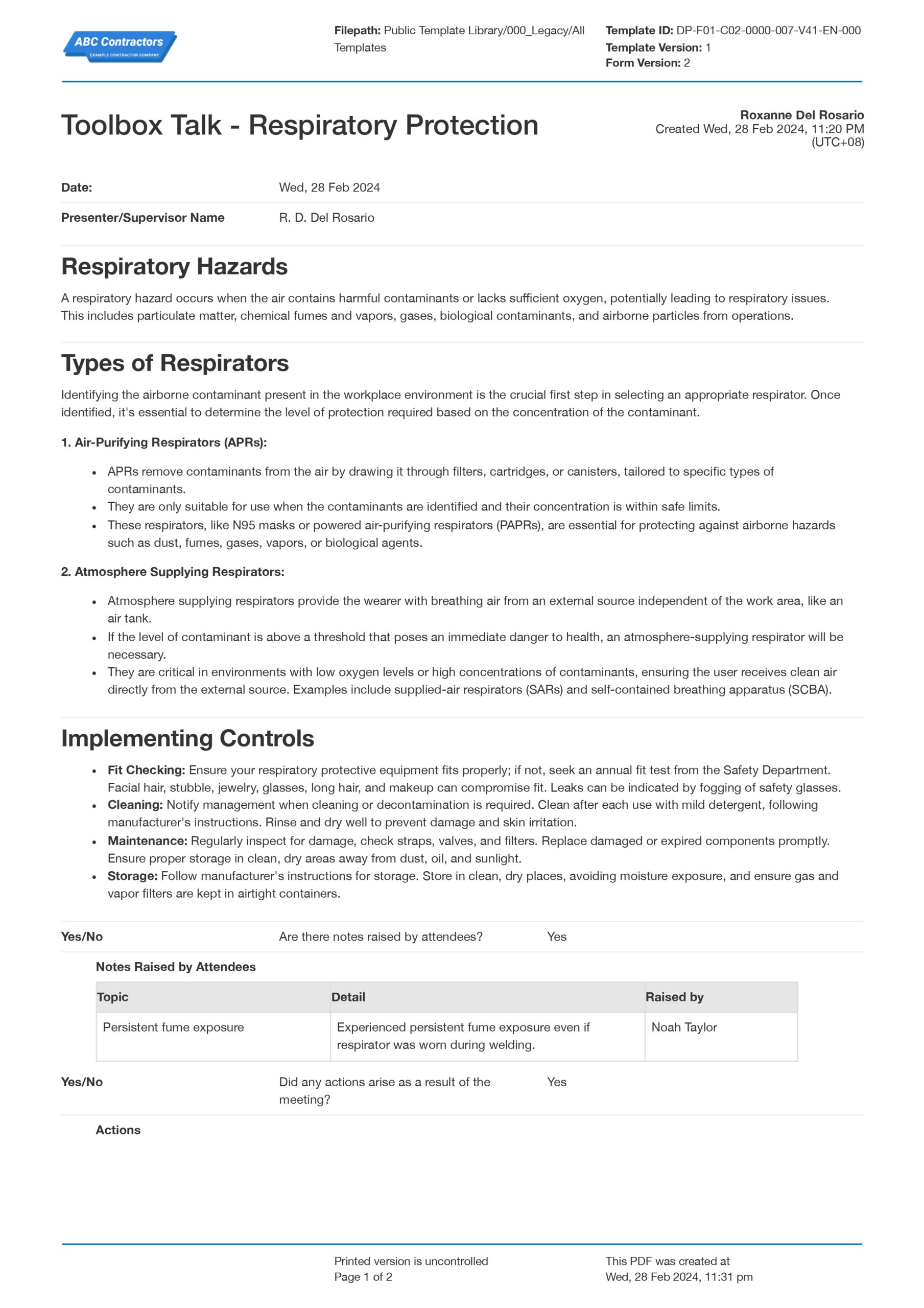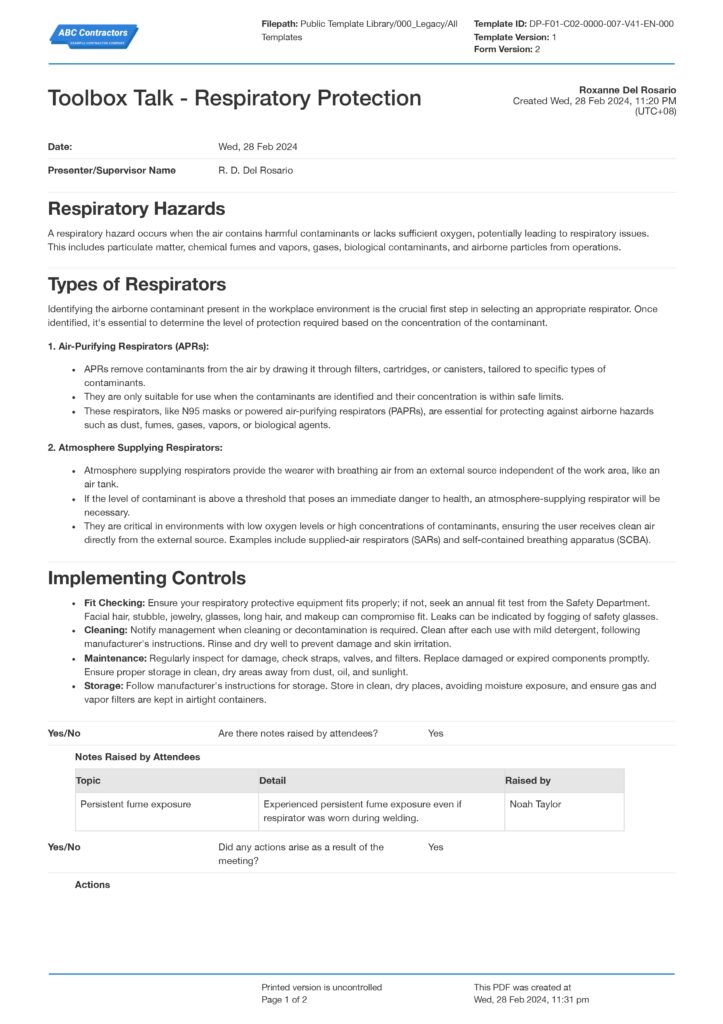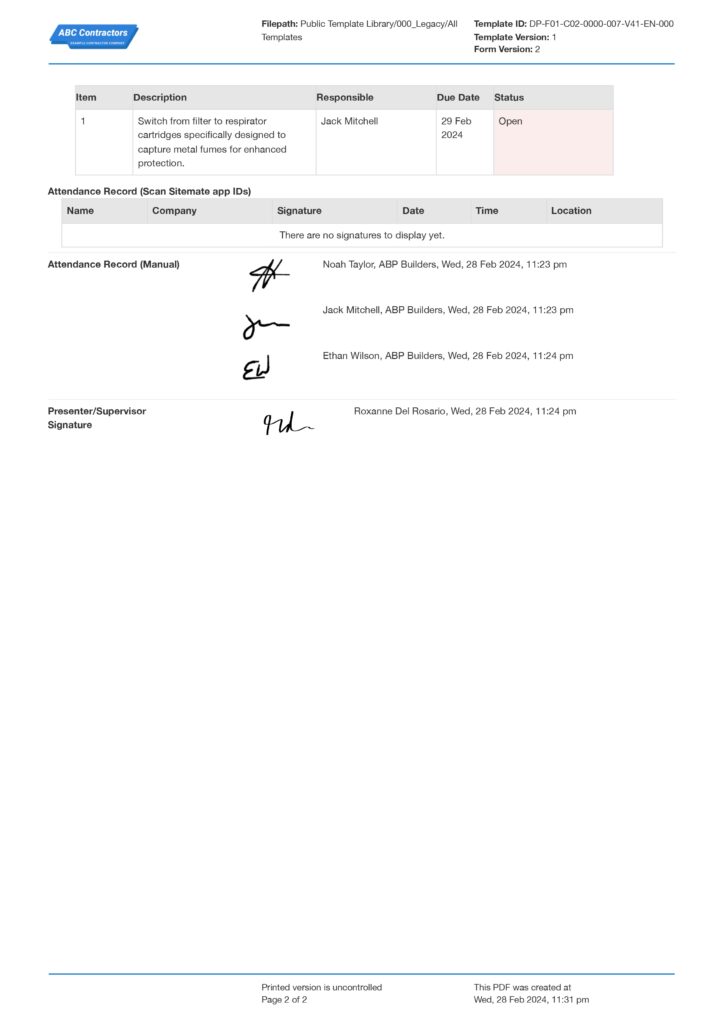Dashpivot Article – Respiratory Protection Factors

Respiratory Protection Factors
What are Respiratory Protection Factors (RPFs)?
Respiratory Protection Factors (RPFs) serve as a crucial benchmark for safeguarding workers from airborne hazards. These factors are quantitative measures indicating the level of respiratory protection provided by different types of respirators.
In settings where workers encounter a variety of particulates, gases, vapors, or other airborne contaminants, understanding and utilising RPFs is vital. The concept revolves around how effectively a respirator can reduce the concentration of harmful substances in the air breathed by the wearer. They are a blend of scientific assessments and practical applications, ensuring that safety is not compromised.
In industries that involve large-scale construction, infrastructure development, or resource extraction, RPFs are a cornerstone of health and safety protocols. A respirator with a high RPF will filter a greater percentage of airborne particles, thus providing a higher level of protection. For example, a respirator with an Assigned Protection Factor (APF) of 100 can reduce the exposure to a hazardous substance to 1/100th of the concentration present in the ambient air. This level of filtration is essential when dealing with environments where air quality may be compromised due to the nature of work, such as areas with high dust, vapor, or particulate matter.
RPFs are a key part of ensuring worker safety, offering a reliable measure for the effectiveness of respiratory protection They guide the selection of appropriate respiratory protective equipment (RPE) for workers in these demanding environments. Providing the right respirator with the appropriate RPF for specific conditions encountered is essential for ensuring safety and efficiency.
This approach ensures that workers are properly equipped to handle the unique challenges posed by their working environment. From particulate filters that capture dust and mist to gas masks that protect against harmful vapors, the variety of RPE available is designed to meet specific needs as determined by RPFs.
Essential Respiratory Protection Factors to Protect Workplace Safety
Understanding the various respiratory protection factors (RPFs) is vital for ensuring safety in the workplace, especially in industries where air quality is a concern. These factors collectively provide a comprehensive approach to selecting, using, and maintaining respiratory protective equipment effectively;
Assigned Protection Factor (APF)
The Assigned Protection Factor is a critical element in respiratory safety. It quantifies the level of air purity a respirator can provide. APFs are numerical values assigned to respirators, giving an indication of their ability to limit exposure to airborne hazards. For instance, a respirator with an APF of 50 can reduce the exposure to a contaminant to 1/50th of its concentration in the ambient environment. In sectors where workers face a mix of particulates and gaseous pollutants, selecting a respirator with an adequate APF is fundamental.
Fit Factor
The effectiveness of any respirator heavily depends on its fit. The Fit Factor refers to the assessment of how well a respirator seals against the face. This factor is determined through fit testing, which should be done regularly to ensure the respirator fits the wearer's face snugly, without leaks. A proper fit is essential to maintain the integrity of respiratory protection, particularly in environments with high particulate matter or harmful vapors.
Filter Efficiency
Respirators come with various filters designed to capture specific types of contaminants. The efficiency of these filters is a key RPF. Filters are rated based on their ability to capture particles of certain sizes. For example, a HEPA filter is highly efficient at capturing very fine particles. The selection of the correct filter type – whether for dust, mists, gases, or vapors – is vital for ensuring workers' respiratory health in settings where air quality is a constant challenge.
Service Life and Maintenance
Another important factor is the service life and maintenance of respiratory protective equipment. Respirators and their components, like cartridges and filters, have limited lifespans. It's essential to adhere to the manufacturer's guidelines for replacement and maintenance. Regular inspection, proper storage, and timely replacement ensure that the equipment maintains its effectiveness and reliability.
Nominal Protection Factor (NPF)
The Nominal Protection Factor is an essential metric in assessing the potential of a respirator. It represents the theoretical maximum level of protection provided under controlled laboratory conditions. Often, the NPF is higher than the APF as it doesn't account for real-world factors like fit and maintenance. Understanding the NPF can help in initially choosing the right respirator, especially in work environments where exposure to airborne hazards is variable.
Protection Factor Categories
Respirators are categorised to simplify the selection process based on the nature of the work environment. In the U.S., for example, the categories include N (Not oil resistant), R (somewhat oil Resistant), and P (oil-Proof), each followed by a number that indicates the filter's efficiency in filtering airborne particles, such as N95 or P100. These categories guide workers in choosing a respirator that matches the specific challenges of their workplace, ensuring enhanced protection against particular types of airborne substances.
Regulatory Standards
Compliance with regulatory standards is another vital respiratory protection factor. Different countries and organizations have set standards for respiratory protection. In the U.S., organizations like NIOSH and OSHA provide guidelines and enforce standards. These regulations ensure that respiratory protective equipment meets safety requirements and offers adequate protection. Adherence to these standards is crucial for ensuring the health and safety of workers in environments where respiratory hazards are present.
Strategies for Addressing Respiratory Protection Factors in the Workplace
To effectively safeguard workers in demanding environments, it's imperative to have a solid understanding and application of respiratory protection factors. The following strategies offer practical approaches to educate and equip workers with the knowledge and tools needed to navigate respiratory hazards effectively.
Implementing Regular Training Sessions
Regular training sessions are a foundational strategy for educating workers about RPFs. These sessions should be comprehensive, covering all aspects of respiratory protection, from the selection and fitting of equipment to understanding the importance of APFs and NPFs. By conducting these sessions periodically, workers stay updated on best practices and new regulations, ensuring continuous learning and adherence to safety standards.
Implementing a Respirator Fit Testing Program
A respirator fit testing program is crucial in ensuring the effectiveness of respiratory protection. This strategy involves periodically testing each worker to ensure their respirator fits correctly, as an improper fit can significantly reduce its effectiveness. Fit testing should be conducted at regular intervals and when any changes occur that could affect the fit, such as weight changes or facial surgery.
Developing and Distributing Educational Materials
Creating and distributing educational materials such as brochures, flyers, or digital content focused on RPFs can reinforce the training. These materials can serve as quick references for workers, detailing different types of respirators, their proper usage, maintenance, and the significance of each RPF. Accessible both during and outside of work hours, these resources aid in embedding respiratory safety knowledge into the workforce's daily routine.
Interactive Workshops
Hosting interactive workshops where workers can engage hands-on with various types of respirators and their components helps in reinforcing theoretical knowledge. These sessions can include activities like correctly fitting different respirators, identifying when filters need to be changed, and understanding the meaning behind different RPF ratings. Interactive workshops encourage active participation and help in solidifying the understanding of RPFs.
Toolbox Talks on Respiratory Protection Factors
Toolbox talks are an effective method for directly addressing the intricacies of RPFs in the workplace. By concentrating on RPFs during these talks, workers can gain a more nuanced understanding of their critical role in workplace safety. Preparing for such a talk involves gathering up-to-date and relevant information specifically about RPFs, focusing on how they apply to the specific tasks and environments encountered in the workplace.
Engaging the audience is a key component of an effective toolbox talk. It's important to foster a two-way dialogue rather than a one-way lecture. Asking open-ended questions and encouraging workers to share their experiences and challenges related to respiratory protection makes the talk more interactive and relevant. Real-world examples that reflect the situations workers face daily can greatly enhance comprehension and relevance.
Following up after the toolbox talk is crucial to ensure the information discussed is implemented and any lingering questions or concerns are addressed. Providing additional resources, such as guidelines or contact information for further queries, and maintaining an open line of communication, help reinforce the talk's content and ensure its effectiveness.
Regular Audits and Feedback Sessions
Conducting regular audits of respiratory safety practices and gathering feedback from the workers can be instrumental in understanding the efficacy of current RPF education strategies. These audits help identify gaps in knowledge or compliance, allowing for timely rectification. Feedback sessions with workers can provide insights into the challenges they face regarding respiratory protection, leading to more targeted and effective educational interventions.
Ensure that you document the strategies that you implement. Work practices, respirator technology, and associated regulations and standards will change over time and affect how RPFs are accounted for when using RPEs. You will have alter your strategies accordingly in order for them to remain effective.
Below is an example of a toolbox talk about respiratory protection that has been recorded using a specialised toolbox talk form:

Hold better toolbox talks on respiratory protection factors with free and customisable forms
Educate your team on respiratory protection factors with customisable toolbox talk forms
A toolbox talk is an effective way to educate workers on important safety topics such as respiratory protection factors. If the use of RPEs is routine in your workplace, you should record your toolbox talks on RPFs so that you can review, adjust, and re-use your discussion points for future meetings.
Consider using this toolbox talk respiratory protection template for your next toolbox talk on RPFs. You can record your respiratory protection discussion points, note down respiratory safety issues, assign action times to resolve them, and record meeting attendance all in the one form.
You can also attach photos and RPF resources to the form. It's fully customisable to suit any additional requirements as well.

Asbestos Management Plan template
Ensure you prepare for, manage and handle asbestos properly throughout your projects.

Eye Protection Toolbox template
Manage eye protection PPE and eye hazards with this digital Eye Protection Toolbox Talk template.

Toolbox Talk Hearing Protection Template
Keep your team's ears safe using this Toolbox Talk Hearing Protection Template.

